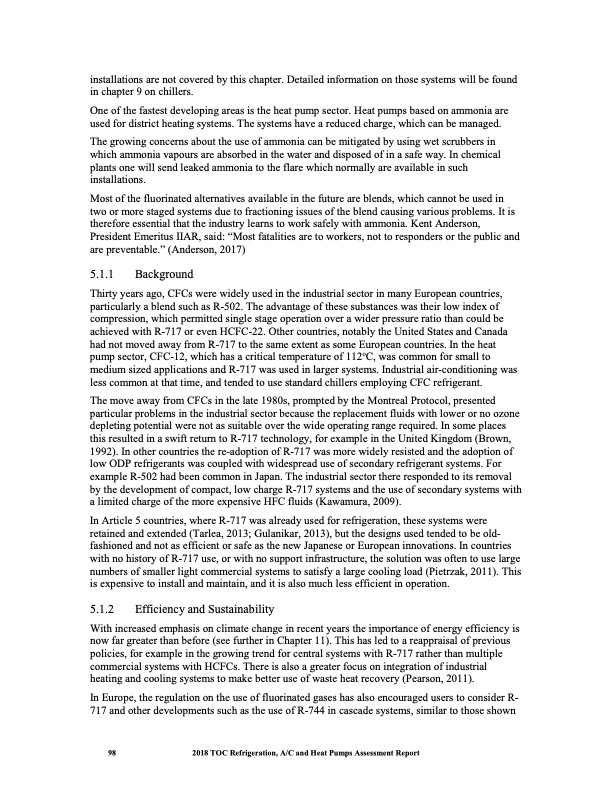
PDF Publication Title:
Text from PDF Page: 111
installations are not covered by this chapter. Detailed information on those systems will be found in chapter 9 on chillers. One of the fastest developing areas is the heat pump sector. Heat pumps based on ammonia are used for district heating systems. The systems have a reduced charge, which can be managed. The growing concerns about the use of ammonia can be mitigated by using wet scrubbers in which ammonia vapours are absorbed in the water and disposed of in a safe way. In chemical plants one will send leaked ammonia to the flare which normally are available in such installations. Most of the fluorinated alternatives available in the future are blends, which cannot be used in two or more staged systems due to fractioning issues of the blend causing various problems. It is therefore essential that the industry learns to work safely with ammonia. Kent Anderson, President Emeritus IIAR, said: “Most fatalities are to workers, not to responders or the public and are preventable.” (Anderson, 2017) 5.1.1 Background Thirty years ago, CFCs were widely used in the industrial sector in many European countries, particularly a blend such as R-502. The advantage of these substances was their low index of compression, which permitted single stage operation over a wider pressure ratio than could be achieved with R-717 or even HCFC-22. Other countries, notably the United States and Canada had not moved away from R-717 to the same extent as some European countries. In the heat pump sector, CFC-12, which has a critical temperature of 112oC, was common for small to medium sized applications and R-717 was used in larger systems. Industrial air-conditioning was less common at that time, and tended to use standard chillers employing CFC refrigerant. The move away from CFCs in the late 1980s, prompted by the Montreal Protocol, presented particular problems in the industrial sector because the replacement fluids with lower or no ozone depleting potential were not as suitable over the wide operating range required. In some places this resulted in a swift return to R-717 technology, for example in the United Kingdom (Brown, 1992). In other countries the re-adoption of R-717 was more widely resisted and the adoption of low ODP refrigerants was coupled with widespread use of secondary refrigerant systems. For example R-502 had been common in Japan. The industrial sector there responded to its removal by the development of compact, low charge R-717 systems and the use of secondary systems with a limited charge of the more expensive HFC fluids (Kawamura, 2009). In Article 5 countries, where R-717 was already used for refrigeration, these systems were retained and extended (Tarlea, 2013; Gulanikar, 2013), but the designs used tended to be old- fashioned and not as efficient or safe as the new Japanese or European innovations. In countries with no history of R-717 use, or with no support infrastructure, the solution was often to use large numbers of smaller light commercial systems to satisfy a large cooling load (Pietrzak, 2011). This is expensive to install and maintain, and it is also much less efficient in operation. 5.1.2 Efficiency and Sustainability With increased emphasis on climate change in recent years the importance of energy efficiency is now far greater than before (see further in Chapter 11). This has led to a reappraisal of previous policies, for example in the growing trend for central systems with R-717 rather than multiple commercial systems with HCFCs. There is also a greater focus on integration of industrial heating and cooling systems to make better use of waste heat recovery (Pearson, 2011). In Europe, the regulation on the use of fluorinated gases has also encouraged users to consider R- 717 and other developments such as the use of R-744 in cascade systems, similar to those shown 98 2018 TOC Refrigeration, A/C and Heat Pumps Assessment ReportPDF Image | Heat Pumps Technical Options

PDF Search Title:
Heat Pumps Technical OptionsOriginal File Name Searched:
RTOC-assessment-report-2018_0.pdfDIY PDF Search: Google It | Yahoo | Bing
CO2 Organic Rankine Cycle Experimenter Platform The supercritical CO2 phase change system is both a heat pump and organic rankine cycle which can be used for those purposes and as a supercritical extractor for advanced subcritical and supercritical extraction technology. Uses include producing nanoparticles, precious metal CO2 extraction, lithium battery recycling, and other applications... More Info
Heat Pumps CO2 ORC Heat Pump System Platform More Info
| CONTACT TEL: 608-238-6001 Email: greg@infinityturbine.com | RSS | AMP |